The British Convoy System in Two World Wars, and winning the Battle of the Atlantic
Introduction.
Although it took until May of 1917 in WW1 for Britain to introduce the convoy system to protect her merchant fleet from marauding German U Boats, the lesson of their efficacy had been well learned. Come the start of WW2 in September 1939, the Admiralty was not tardy in this regard, and convoys to and from Northern America were soon instituted.
The first outbound convoy from Britain, sailed on the 7th. of September, and from Halifax, the first in bound convoy for UK, left on the 16th. of September.
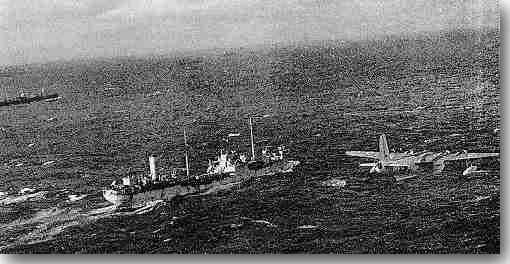
Atlantic convoy under air protection from Coastal Command
World War 1.
WW1 commenced in 1914, but it was not until May of 1917 that the Admiralty was finally forced to introduce a convoy system. Prior to then, my Lords felt that
( a ) the submarine was a defensive weapon, and that in general, it was unthinkable that it would be deployed in sinking merchant ships, " Not really cricket you know."
( b ) The major task of the Royal Navy was offensive, and was designed to bring the German Fleet to a major battle.
( c ) The protection of trade was purely defensive, and to provide Naval escorts for convoys would deplete the fleet. All top Naval thinking was based on taking the
offensive.
Why then did this view change?
In 1915, German U-Boats accounted for 400 ships adding up to total a million tons. The following year the tonnage sunk doubled, made up of 964 ships. In fact, the war might well be lost if merchant ships continued to fall prey to enemy submarines at that alarming rate.
Britain needed to import across the Atlantic Ocean from North America, a large proportion of the food needed for her population to survive, plus the necessary military supplies destined for the armies fighting in France.
The German Chief of Naval Staff.
In February of 1917, Germany resumed unrestricted submarine warfare, and the German Chief of Naval Staff, Admiral von Holtzendorff, believed his submarine fleet could account for 600,000 tons of British and Allied shipping per month, and if that proved sustainable, that level of loss would bring Britain to her knees, and force her to the peace table.
British Shipping losses for February/April in 1917.
Losses to German Submarines over February/April 1917 were:-
- February, 464,5999 tons.
- March, 507,001 tons.
- April, 834,549 tons.
These 3 months averaged 602,000 tons a month, remarkably close to the prediction of the German Chief of Naval Staff, even a touch higher than he thought his boats might achieve. In turn, the cost to the German Imperial Navy, a mere 10 U-boats. The effect on Neutral shipping was devastating, in that February alone, 600 ships in Allied ports refused to put to sea.
Jellicoe, the British First Sea Lord, on the 26th. of Apil 1917 received a memo from Rear Admiral Duff in which he wrote: " It seems to me, evident that the time has arrived when we must be ready to introduce a comprehensive scheme of convoy at any moment."
How very true, and really overdue.
Another factor, on the 6th. of April in 1917, the United States at last realised she had to get into this fight, and declared war on Germany. Thus, the prospect of the availability of increased escorts for convoys was much enhanced.
The coal trade to France.
Industry in France was dependent upon British coal imports, and in February 1917 " Controlled Sailings " with trawler escorts had started, and only 5 ships were lost from 2,600 that sailed in convoy. The stage was indeed set for Briain to embrace the Convoy system.
On the 10th. of May, 17 merchant ships left Gibraltar in a trial convoy, its speed but 6.5 knots, three armed trawlers, and 2 Q ships escorted them through the danger area, and as far as 11 degrees West. Then, when 200 miles from the English Channel, 8 destroyers picked them up to bring them safely into port.
Over May/June, 73 ships, in 5 UK bound convoys sailed from Hampton Roads in Virginia, to lose but one straggler to a torpedo.
From August onwards, the rate of ships lost to enemy submarines was falling, and by year end, even a reluctant Admiralty had to admit any doubts about the effectiveness of the introduced convoy system, was at last removed.
WW2 declared.
When WW2 wasdeclared on the 3rd. of September 1939, this time round the British Admiralty was better prepared, a vast organisation of Naval Control Service Officers, and Sea Transport Officers, at the main ports where convoys would be formed, and overseas was quickly activated.
Two comments.
Hitler on 9 October, 1939, made this comment, "Used ruthlessly, the Submarine, can today, be an extraordinary threat to Britain."
Churchill said, " Battles might be won or lost, enterprises succeed or miscarry, Territories might be gained or quitted, but, dominating all our power to carry on the war, or even keep ourselves alive, was our mastery of the ocean routes, and free approach and entry to our ports. The only thing that ever frightened me during the war was the U-Boat peril."
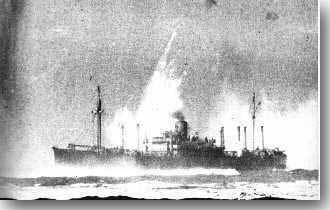
Ship in convoy is hit by a U-Boat torpedo.
Shortage of long range anti-submarine escort ships.
The Royal Navy was painfully short of suitably fitted anti-submarine escort ships, at the start of WW2, only 200 ships were fitted with ASDIC, and about half of them dated back to WW1, designed to operate in the North Sea area, close to their home ports, and having a very limited range. The newer and faster destroyers were slated to screen the Home and Mediterranean fleets.
Thus, outbound convoys were escorted only some 100 miles west of Ireland, the convoy ships sailed in company for the next two days, to scatter, and go it alone to their final destination ports. At the time of scattering, all merchant ships were well inside the operating limits of the U-Boats, and very vulnerable to attack from them.
The German U-Boat scene.
Admiral Donitz in charge of the German U-Boat arm, could only field 19 boats in the Western Approaches when war came, his total of Submarines in commission was 56, with 46 operational, but only 22 were suitable for North Atlantic service, the rest were but 250 ton boats with a short operational range, essentially they could be deployed in the North Sea.
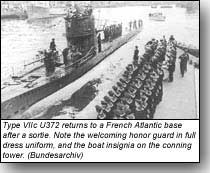
U-372 returns to her French base after an Atlantic patrol
Sinking of Athenia by U-30.
On the 3rd. of September, only 12 hours into WW2, U-30 sank the liner Athenia, with heavy loss of life, and the Battle of the Atlantic then raged unabated until May 1943, when the Allied naval escorts got on top of the their opponents and Donitz withdrew his boats from the Atlantic, unable to sustain such heavy losses.
Air Cover for Convoys in WW2.
The Royal Air Force still had Coastal Command under its wing, and it was rather like a poor child in an orphanage. Air cover for convoys was non existent early in WW2, CC's aircraft were obsolescent and their crews poorly trained.
It was not until the 11th. of April 1941, that the wise decision was taken to strip control of Coastal Command from the Royal Air Force and vest it in the Admiralty. They in turn, gave control of CC to C-in-C Western Approaches in Liverpool, so at last, all the tools to combat the U-Boat menace were tightly held by a single entity.
By December 1942, 120 Squadron of Coastal Command operating Liberators out of Northern Ireland, and Iceland, were assisting the convoy ocean escorts to combat the agressive U-Boats, and in general, when air and sea assets were jointly used to protect a convoy, losses were lightest.
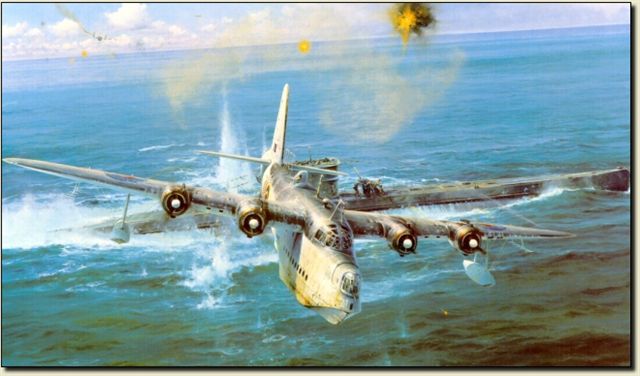
A Sunderland Flying Boat from Coastal Command attacks a U-Boat
Radar.
Radar played its part both at sea, and in the air in locating U-Boats when they were running on the surface, forcing them to crash dive, which slowed up their speed under water.
Weapons.
The major sea borne weapon against the U-boat was the depth charge, despatched via stern rails and throwers, its main drawback being the dead time after the escort passed over it target, and the distance steamed before the depth charges could be released.
It was replaced with the ahead throwing weapon Hedgehog, 24 projectiles fired from spigots placed on deck in the ship's bow. A projectile did not explode unless it made a hit upon the submarine, if all missed, there was no deterrent as there was with an exploding depth charge.
Hedgehog was replaced with Squid, set to explode at the set depth, it was an ahead throwing weapon mounted on the escort's stern and threw its projectiles over the bridge to land well ahead of the attacking ship. The gunnery people now got their precious bow gun back.
Rescue Ships.
By 1941, special Rescue Ships were fitted out and sailed in the last column within convoys. 29 were used to June 1945, they sailed some 2,225,000 miles on 796 voyages to pick up 4,200 Allied sailors.
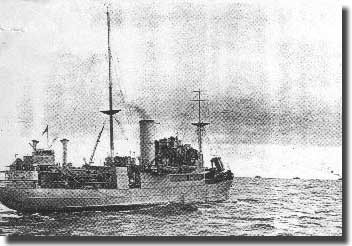
A Rescue ship at sea with its convoy
Statistics from both sides involved in the battle in WW1 and WW2.
Some horrific statistics follow, taken from " The Battle of the Atlantic. The Official Account of the Fight Against the U-Boats. 1939-1945. London. His Majesty's Stationery Office.
In World War 1, 1914-1918.
Submarines sank 4,837 merchant ships to total 11,135,000 tons, with an average monthly sinking of 95 ships.
In World War 11, 1939-1945.
Submarines sank 2,775 merchant ships to total 14,500,000 tons, to average monthly sinkings of 40 ships.
Interestingly, the average monthly tonnage sunk was about the same in both wars at 215,000, the fact that in WW1, the number of ships sunk was almost double that of WW2 is explained by the fact that over 1914-1918, the average ship's tonnage was 2,300 whilst over 1939-1945 it had risen to 5,200 tons.
Enemy Submarines sunk WW2.
781 U-Boats and 81 Italian submarines were destroyed over WW2. Of the 781 German boats, 635 were sunk by Allied warships, aircraft or mines, 63 were destroyed by Allied bombing, and 83 lost to grounding, collision or other causes.
The Naval and Air Forces under British control accounted for 503 sinkings at sea, whilst the Naval and Air Forces under United States control accounted for 132 sinkings at sea.
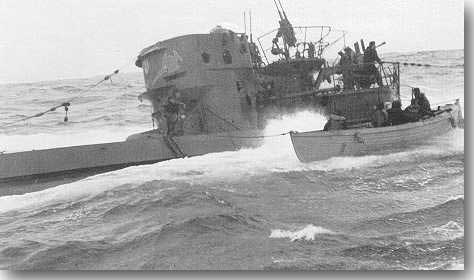
U-744 forced to surface, March the 6th. 1944 by depth charging in North Atlantic, her crew scuttled the boat, and 40 were taken POW from her crew of 51. HMCS Chilliwack's boat's crew boarding her to retrieve valuable material prior to the U- Boat sinking
Allied Merchant Navy Personnel.
Of 30,000 Merchant Navy personnel casualities, 23,000 were the result of U-Boat action.
Coastal Command's role in the Battle of the Atlantic.
Coastal Command played an important role in the winning of the Battle of the Atlantic. CC including some aircraft manned by Australian crews, with aircraft from the Royal Canadian Air Force flew 120,000 sorties, 850,000 flying hours to total 100 million miles.
Coastal Command losses.
5,866 air crew died, and 1,777 aircraft were lost.
German Navy Personnel losses in U-Boats.
Of the 40,900 who served in the U-Boat arm, 28,000 died, a 70% ratio, and 5,000 were captured.
Royal Navy losses.
The incredible figure for casualities in the Royal Navy is 73,642, of whom 50,758 died with a further 800 missing. ( As quoted by John Terraine in his: Business in Great Waters. The U-Boat Wars 1916-1945. Mandarin Paperbacks. London. 1989. )
175 warships were sunk by U-Boats.
Royal Canadian Navy Personnel losses.
1,965 Officers and Sailors died.
Merchant ships in convoy steamed an amazing 200 million miles, whilst British Naval Escorts made 13,200 separate voyages.
Conclusion.
Late in WW1, the convoy system was put into place to prove it usefulness, but come WW2, it played a significent role, forging vital links in the chain bringing final victory in that battle we just had to win, The Battle of the Atlantic.
To sum up, I can do no better than to quote the last paragraph from the official HMSO document: "The Battle of the Atlantic."
" In truth, the Battle of the Atlantic was won by the entire peoples of the United Nations. It was the triumph of right over evil- the calm determination of men and women of many different races, languages and creeds, no matter at what personal sacrifice, to prevent the domination and enslavement of the world."






